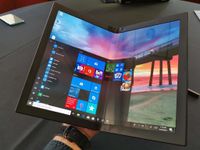Razer is sure making some exciting moves when it comes to gaming chairs. We reviewed the Iskur (one of the best gaming chairs) and recently Enki X, both of which bring refreshing new features and designs to the boring and stagnate chair industry.
Like Chroma (for RGB lighting), HyperSense is Razer’s proprietary term for haptic feedback introduced in 2019, and it has been used in various accessories including its Kraken V3 HyperSense headphones.
But now, the company is putting it into a chair: The Enki Pro HyperSense for CES 2022. Yes, this is a chair that vibrates. And it has Chroma RGB, because of course, it does.
Interestingly, Razer teased such a chair back in 2019 CES, where it demoed a working concept. But now, it’s a reality.
Razer teamed up with D-BOX for the haptic technology, which sits near the feet in the chair’s base.
Why do such a crazy thing? From the PR announcement, Razer notes that the Enki Pro HyperSense delivers “the most authentic, lifelike feedback when gaming, and also integrates a Chroma RGB headrest that allows users to personalize their chair when in use.” The chair “physically transforms the experience of games, movies, and music through the use of cutting-edge high-fidelity haptic feedback.”
Because of how HyperSense is designed, it just works with over 2,200 games, movies, and music already. They cite popular titles like F1 2021, Forza Horizon 5, and Assassin’s Creed Valhalla as examples.
But what if the game isn’t supported? That’s not a problem, either:
Even games not directly supported through the software can still be enjoyed with haptic feedback through Direct Input Haptics, where controller, keyboard and mouse-inputs will generate physical feedback when used. The haptic feedback isn’t just limited to gaming, as media consumption also benefits from an extra layer of immersion, with many of the most popular streaming platforms being automatically supported. Viewers and listeners will enjoy greater depth and envelopment as music, sound effects and soundtracks can be felt as well as heard.
The technology behind the haptics, delivered by D-BOX, sounds (or, ahem, feels) intense:
The Enki Pro HyperSense is powered by an advanced haptic engine that has been developed to simulate a range of vibrations, textures, and motions. With 65,000 haptic variations it has the tactile feedback of +/- 1 G-Force and can create 1.5 inches of vertical and backward tilt in your seat. Real time synchronization ensures that all the feedback is delivered immediately, with a responsiveness of up to 5ms.
Of course, we have many questions about this chair, including do you plug it in? How much does it cost? When can we buy one? Will the wife be OK with this?
We’re meeting up with Razer soon, so we’ll update this article with more info as we get it.
In addition to the Enki Pro HyperSense, Razer is also showing off its radical new concept dubbed “Project Sophia,” which is worth your time to check out. We’re also still waiting on the “Project Brooklyn” gaming chair to come to market someday.

More foldable screen Windows PCs are expected to begin shipping this year
Intel has today announced a new foldable display spec for its PC partners that will enable new and unique device form factors with foldable screens. Intel says the first foldable PCs adopting this new spec will begin shipping this year, opening the door to a flurry of new and unique Windows PCs.

Best Razer Blade Pro 17 Alternatives
The Razer Blade Pro 17 is a great gaming laptop, but if you don’t want one, there are plenty of other laptops on the market, too. Here are the ones we recommend.




